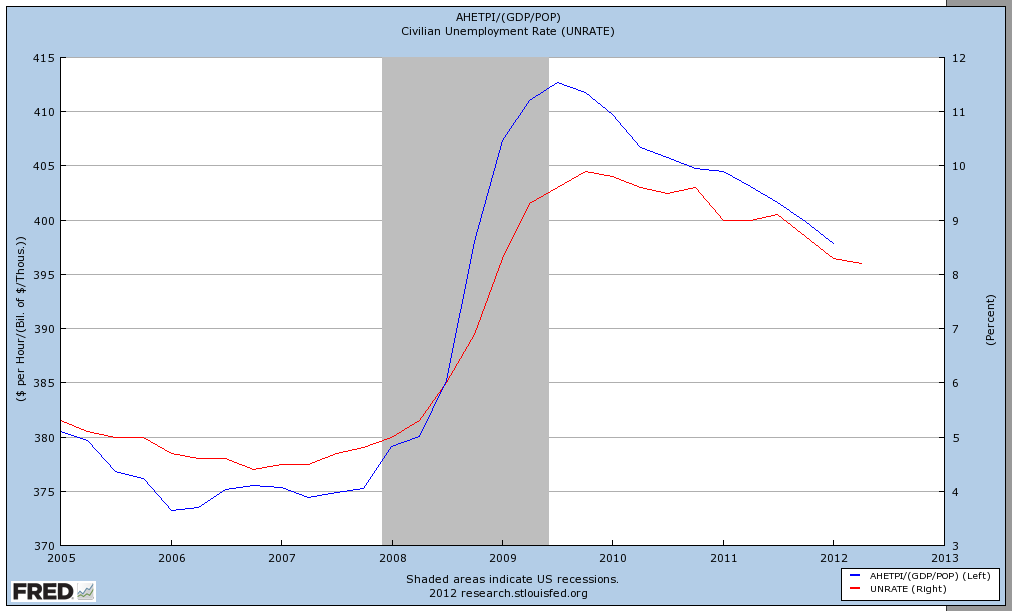Recent links
I’m still catching up on things, but here are a few pieces worth reading.
Ramesh Ponnuru at Bloomberg:
My guess is that Obama doesn’t know, think or care much about monetary policy. That’s usually a good disposition for someone in the Oval Office to have. A president who was too interested in monetary policy would be tempted to interfere with the Fed. Indifference beats the attitude of many Republicans, who are still convinced, contrary to all the evidence, that rampant inflation is just around the corner.
While presidential apathy about central banking is usually a virtue, once every 70 years or so the economy suffers through a calamity of tight money. We found ourselves in that circumstance when Obama took office. The country could have been well served by a president who favored monetary looseness, a policy the Democratic Party has supported for about a century. Because of Obama’s indifference, we had no such luck.
A lot of conservatives have adopted screwy ideas about monetary policy during the Obama years. They have been urging the Fed to tighten a policy that is already too tight. But the monetary mistakes of liberals have been the most consequential ones during these years. The likely nomination of Summers doesn’t suggest that we’ll see an improvement anytime soon.
Exactly. And here’s an earlier Ponnuru article in National Review:
Many analysts on the left and right accept this basic story but disagree about what caused the mortgage bubble. Conservatives tend to emphasize Fannie Mae, Freddie Mac, and the Federal Reserve’s low-interest-rate policy. Liberals tend to emphasize predatory lenders who tricked people into borrowing more than they could afford, Wall Streeters who took on too much risk, and regulators who allowed all of it to happen. These are not mutually exclusive explanations, of course, so it is possible to mix and match.
Yet it may be that both sides are mistaken, and mistaken precisely in their point of agreement: that the housing boom and bust is the fundamental explanation for our recent economic troubles. It may be that this crisis was indeed brought to us by government policies, but not the ones that the dominant voices on either side of the political divide have in mind.
If so, it will not be the first time that an economic depression was misunderstood by the people living through it. The modern view of the Great Depression, held by almost everyone in the field of economics, is that monetary contraction was the chief cause of the disaster. At the time, though, the prevailing view was that the depression resulted from a stock-market crash and banking crisis that in turn resulted from financial speculation.
Contemporary observers, including most influential economists, certainly did not see extremely tight money as the root cause of the Depression. Indeed, they did not believe that money was tight at all. Interest rates were very low, and the monetary base was growing: both things that many people, then and now, associated with expansive monetary policy. Officials and commentators worried that loosening money “” loosening it, they thought, still further “” would lead to more of the speculation that had started the calamity.
It was not until decades later, with the 1963 publication of Milton Friedman and Anna Schwartz’s A Monetary History of the United States, that the monetary mistakes of the era were understood. Interest rates were low not because money was loose but because it was tight: Monetary contraction had depressed the economy and thus expected returns to investment.
It’s good to see the press paying more attention to MM views of the crisis.
Lars Christensen sent me the following from The Guardian:
If you want to know the likely outcome of the next general election or the Eurovision song contest, consult a bookmaker. Bookies’ odds have a long and honourable record of being ahead of the game, for good reason: they reflect the opinions of specialists and insiders who are prepared to back their views with hard cash.
Could the principle work for economic forecasting?
The Adam Smith Institute, in mischievous mode, has encouraged Paddy Power to open betting markets covering the rate of UK inflation and the rate of unemployment on 1 June 2015. It’s 9-4 that CPI inflation will be 3.01%-4% and 5-2 that unemployment will still be in the 7%-8% range.
“The Bank of England‘s economic forecasts have been wrong again and again,” says the thinktank. It wonders if the fabled “wisdom of crowds” can do better.
. . .
The Adam Smith Institute is dreaming if it thinks the government would ever get rid of its experts and outsource its forecasts to “prediction markets”.
It may seem like a dream today, but it’s only a matter of time before the economics profession wakes up to the fact that markets are better than bureaucrats at stablizing the path of NGDP. In the future, monetary policy decision-making by committee will seem something like voodoo, another barbarous relic.


